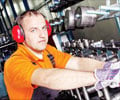The noise in a hospital can be quite disturbing and many patients complain of not getting a good night's sleep.
The noise in a hospital can be quite disturbing and many patients complain of not getting a good night's sleep.
But a study published in the December issue of the Journal of Clinical Nursing has shown that adopting some simple measures can reduce peak noise levels on hospital wards by just under 20 per cent.UK researchers from Newcastle upon Tyne audited average decibel levels before and after a noise reduction intervention programme on three wards with a total of 92 beds - a surgical ward, medical ward and orthopaedic ward.
Forty-six ward staff – just over 51 per cent of the total – took part in the initiative, along with five members of the multi-disciplinary team, including a physiotherapist and junior doctors. The training was delivered on an individual basis by the same staff nurse to ensure consistency.
"Hospitals can be very noisy places" explains lead author Annette Richardson, a nurse consultant in critical care at Newcastle upon Tyne Hospitals NHS Foundation Trust. "Dropping a stainless steel bowl creates 108 decibels, which is more than the 100 decibels from a nearby car horn or chainsaw. Even opening a packet of rubber gloves creates 86 decibels, which is louder than heavy traffic at 80 decibels.
"Our study found that peak decibel levels at the start of the study were 96.48 decibels over 24 hours and at the end of the study they had gone down to 77.52 decibels, an overall reduction of just under a fifth."
After the initial noise levels were monitored, key parts of the ward environment were reviewed against clinical guidelines put together by a working group led by a nurse consultant and involving ward sisters, staff nurses and modern matrons from the different specialist areas.
Advertisement
"A number of practical steps were taken to reduce noise" says Ms Richardson who won a prestigious Nursing Times award for her clinical work in promoting sleep for critical care patients.
Advertisement
"We also displayed posters at nursing stations highlighting the noise created by certain activities, the impact on patients and sleep promotion guidelines."
When the pre and post intervention noise levels were measured they were found to be remarkably similar on all three wards, despite the fact that they operate differently. Peak levels in the surgical ward fell by 18 per cent from 95.13 decibels to 77.65, in the medical ward they fell by 20 per cent from 97.04 decibels to 77.70 and in the orthopaedic ward they fell by 21 per cent from 97.27 decibels to 77.52.
UK legislation expects employers to carry out a risk assessment if employees are exposed to peak levels higher than 80 decibels, but no patient focused standards are set for the National Health Service. However, the United States Environmental Protection Agency recommends levels of 45 decibels for day-time noise in hospital settings and 35 decibels for night-time noise. Meanwhile, the World Health Organization has recommended that noise levels should not exceed 35 decibels in rooms where patients are treated or observed.
"The main significant finding of our study was the reduction in average peak noise levels on all wards" says Ms Richardson. "Previous studies have shown how patients can become accustomed to low-level white noise, but they can be more aware of high pitched, irregular sounds.
"Sleep deprivation is detrimental to patients with acute illness, so any developments to improve patients' sleep are important.
"This nurse-led practice development programme has shown how improvements can be achieved by significantly reducing peak noise levels by making simple changes to ward routines."
Source-Eurekalert
SAV















